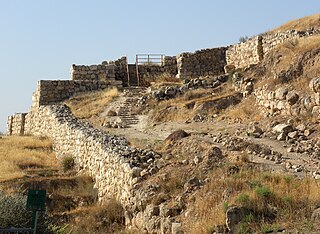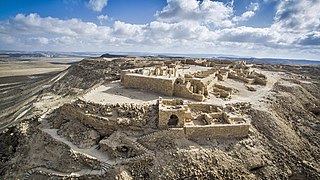
Antipatris was a city built during the first century BC by Herod the Great, who named it in honour of his father, Antipater. The site, now a national park in central Israel, was inhabited from the Chalcolithic Period to the late Roman Period. The remains of Antipatris are known today as Tel Afek, although formerly as Kŭlat Râs el 'Ain. It has been identified as either the tower of Aphek mentioned by Josephus, or the biblical Aphek, best known from the story of the Battle of Aphek. During the Crusader Period the site was known as Surdi fontes, "Silent springs". The Ottoman fortress known as Binar Bashi or Ras al-Ayn was built there in the 16th century.

Lachish was an ancient Israelite city in the Shephelah region of Canaan on the south bank of the Lakhish River mentioned several times in the Hebrew Bible. The current tell by that name, known as Tel Lachish or Tell el-Duweir, has been identified with Lachish. Today, it is an Israeli national park operated and maintained by the Israel Nature and Parks Authority. It lies near the present-day moshav of Lakhish, which was named in honor of the ancient city.

Amihai "Ami" Mazar is an Israeli archaeologist. Born in Haifa, Israel, he has been since 1994 a professor at the Institute of Archaeology of the Hebrew University of Jerusalem, holding the Eleazer Sukenik Chair in the Archaeology of Israel.

Tel Rehov or Tell es-Sarem, is an archaeological site in the Bet She'an Valley, a segment of the Jordan Valley, Israel, approximately 5 kilometres (3 mi) south of Beit She'an and 3 kilometres (2 mi) west of the Jordan River. It was occupied in the Bronze Age and Iron Age.

Benjamin Mazar was a pioneering Israeli historian, recognized as the "dean" of biblical archaeologists. He shared the national passion for the archaeology of Israel that also attracts considerable international interest due to the region's biblical links. He is known for his excavations at the most significant biblical site in Israel: south and south west of the Temple Mount in Jerusalem. In 1932 he conducted the first archaeological excavation under Jewish auspices in Israel at Beit She'arim and in 1948 was the first archaeologist to receive a permit granted by the new State of Israel. Mazar was trained as an Assyriologist and was an expert on biblical history, authoring more than 100 publications on the subject. He developed the field of historical geography of Israel. For decades he served as the chairman of the Israel Exploration Society and of the Archaeological Council of Israel. Between 1951 and 1977, Mazar served as Professor of Biblical History and Archaeology at the Hebrew University of Jerusalem. In 1952 he became Rector of the university and later its president for eight years commencing in 1953.

Avdat or Ovdat, and Abdah or Abde, are the modern names of an archaeological site corresponding to the ancient Nabataean, Roman and Byzantine settlement of Oboda or Eboda in the Negev desert in southern Israel. It was inhabited with intermissions between the 3rd century BCE and the mid-7th century CE by Nabataeans, in their time becoming the most important city on the Incense Route after Petra, then by Roman army veterans, and Byzantines, surviving only for a few years into the Early Muslim period. Avdat was a seasonal camping ground for Nabataean caravans travelling along the early Petra–Gaza road in the 3rd – late 2nd century BCE. The city's original name was changed in honor of Nabataean King Obodas I, who, according to tradition, was revered as a deity and was buried there.

David Ussishkin is an Israeli archaeologist and professor emeritus of archaeology.

The Israel Antiquities Authority is an independent Israeli governmental authority responsible for enforcing the 1978 Law of Antiquities. The IAA regulates excavation and conservation, and promotes research. The Director-General is Mr. Eli Escusido, and its offices are housed in the Rockefeller Museum.

The Israel Exploration Society (IES), originally the Jewish Palestine Exploration Society, is a society devoted to historical, geographical and archaeological research of the Land of Israel. The society was founded in 1913 and again in 1920, with the object of studying the history and civilization of the Land of Israel and of disseminating its knowledge.

Yosef Garfinkel is an Israeli archaeologist and academic. He is a professor of Prehistoric Archaeology and of Archaeology of the Biblical Period at the Hebrew University of Jerusalem.

The Yarmukian culture was a Pottery Neolithic A (PNA) culture of the ancient Levant. It was the first culture in prehistoric Syria and one of the oldest in the Levant to make use of pottery. The Yarmukian derives its name from the Yarmuk River, which flows near its type site of Sha'ar Hagolan at the foot of the Golan Heights. This culture existed alongside the Lodian, or Jericho IX culture and the Nizzanim culture to the south.

Avidov Lipsker is an Israeli professor of Hebrew Literature at Bar Ilan University in Israel.

Ephraim Stern was an Israeli archaeologist and professor at the Hebrew University of Jerusalem. He specialized in the archaeology of ancient Israel and Judah and Phoenicia, and was known for his excavations at Tel Dor (1980–2000). He received the EMET Prize in 2005.

Hanan Eshel was an Israeli archaeologist and historian, well known in the field of Dead Sea Scrolls studies, although he did research in the Hasmonean and Bar Kokhba periods as well. With Magen Broshi he discovered a number of residential caves in the near vicinity of Qumran and co-published a number of historically significant documents from Qumran.

Prof. Christopher A. Rollston is a scholar of the ancient Near East, specializing in Hebrew Bible, Greek New Testament, Old Testament Apocrypha, Northwest Semitic literature, epigraphy and paleography.

Oded Lipschits is an Israeli professor in the Department of Archaeology and Ancient Near East Studies at Tel Aviv University. In 1997 he earned his Ph.D. in Jewish History under the supervision of Nadav Na'aman. He has since become a Senior Lecturer and Full Professor at Tel Aviv University and served as the Director of the Tel Aviv Institute of Archaeology since 2011. Lipschits is an incumbent of the Austria Chair of the Archeology of the Land of Israel in the Biblical Period and is the Head and founder of the Ancient Israel Studies Masters program in the Department of Archaeology and Ancient Near East Studies.

Khirbet et-Tibbâneh (Arabic: خربة التبانة), sometimes referred to by historical geographers as the Timnah of Judah, is a small ruin situated on a high ridge in the Judaean mountains, in the Sansan Nature Reserve, 622 metres (2,041 ft) above sea level, about 3 kilometers east of Aviezer and ca. 7 kilometers southeast of Bayt Nattif.

Samuel Klein was a Hungarian-born rabbi, historian and historical geographer in Mandatory Palestine.
Tel Hashash or Tell el-Hashash is an archaeological site in the heart of the Bavli neighborhood of Tel Aviv. It is one of the ancient sites along the Yarkon River, located 800 meters south of the river, overlooking Tell Qasile on the northern bank of the river. The site was excavated in the 1960s by Jacob Kaplan on behalf of the Old Jaffa Museum of Antiquities, and in the 1980s by Haya Ritter Kaplan of the Israel Antiquities Authority. The excavations exposed remains of the first century CE and the late Byzantine period.

















